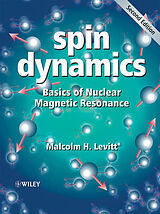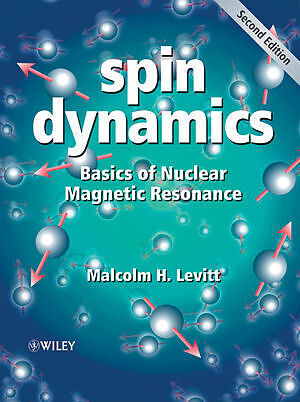Spin Dynamics
Einband:
Kartonierter Einband
EAN:
9780470511176
Untertitel:
Basics of Nuclear Magnetic Resonance
Genre:
Natur & Technik
Autor:
Malcolm H. Levitt
Herausgeber:
Wiley John + Sons
Auflage:
08002 Auflage 2nd Edition. Second Edition
Anzahl Seiten:
714
Erscheinungsdatum:
07.03.2008
ISBN:
978-0-470-51117-6
Spin Dynamics: Basics of Nuclear Magnetic Resonance, Second Edition is a comprehensive and modern introduction which focuses on those essential principles and concepts needed for a thorough understanding of the subject, rather than the practical aspects.
Autorentext
Professor Malcolm Levitt, School of Chemistry,?University of Southampton, UK.
Klappentext
Spin Dynamics: Basics of Nuclear Magnetic Resonance, Second Edition is a comprehensive and modern introduction which focuses on those essential principles and concepts needed for a thorough understanding of the subject, rather than the practical aspects. The quantum theory of nuclear magnets is presented within a strong physical framework, supported by figures. The book assumes only a basic knowledge of complex numbers and matrices, and provides the reader with numerous worked examples and exercises to encourage understanding. With the explicit aim of carefully developing the subject from the beginning, the text starts with coverage of quarks and nucleons and progresses through to a detailed explanation of several important NMR experiments, including NMR imaging, COSY, NOESY and TROSY. Completely revised and updated, the Second Edition features new material on the properties and distributions of isotopes, chemical shift anisotropy and quadrupolar interactions, Pake patterns, spin echoes, slice selection in NMR imaging, and a complete new chapter on the NMR spectroscopy of quadrupolar nuclei. New appendices have been included on Euler angles, and coherence selection by field gradients. As in the first edition, all material is heavily supported by graphics, much of which is new to this edition. Written for undergraduates and postgraduate students taking a first course in NMR spectroscopy and for those needing an up-to-date account of the subject, this multi-disciplinary book will appeal to chemical, physical, material, life, medical, earth and environmental scientists. The detailed physical insights will also make the book of interest for experienced spectroscopists and NMR researchers. An accessible and carefully written introduction, designed to help students to fully understand this complex and dynamic subject. Takes a multi-disciplinary approach, focusing on basic principles and concepts rather than the more practical aspects. Presents a strong pedagogical approach throughout, with emphasis placed on individual spins to aid understanding. Includes numerous worked examples, problems, further reading and additional notes.
Inhalt
Preface. Preface to the First Edition. Introduction. Part 1 Nuclear Magnetism. 1 Matter.
1.1 Atoms and Nuclei.
1.2 Spin.
1.3 Nuclei.
1.4 Nuclear Spin.
1.5 Atomic and Molecular Structure.
1.6 States of Matter.
Notes.
Further Reading.
Exercises. 2 Magnetism.
2.1 The Electromagnetic Field.
2.2 Macroscopic Magnetism.
2.3 Microscopic Magnetism.
2.4 Spin Precession.
2.5 Larmor Frequency.
2.6 Spin-Lattice Relaxation: Nuclear Paramagnetism.
2.7 Transverse Magnetization and Transverse Relaxation.
2.8 NMR Signal.
2.9 Electronic Magnetism.
Notes.
Further Reading.
Exercises. 3 NMR Spectroscopy.
3.1 A Simple Pulse Sequence.
3.2 A Simple Spectrum.
3.4 Relative Spectral Frequencies: Case of Positive Gyromagnetic Ratio.
3.5 Relative Spectral Frequencies: Case of Negative Gyromagnetic Ratio.
3.6 Inhomogeneous Broadening.
3.7 Chemical Shifts.
3.8 J-Coupling Multiplets.
3.9 Heteronuclear Decoupling.
Notes.
Further Reading.
Exercises. Part 2 The NMR Experiment. 4 The NMR Spectrometer.
4.1 The Magnet.
4.2 The Transmitter Section.
4.3 The Duplexer.
4.4 The Probe.
4.5 The Receiver Section.
4.6 Overview of the Radio-Frequency Section.
4.7 Pulsed Field Gradients.
Notes.
Further Reading. 5 Fourier Transform NMR.
5.1 A Single-Pulse Experiment.
5.2 Signal Averaging.
5.3 Multiple-Pulse Experiments: Phase Cycling.
5.4 Heteronuclear Experiments.
5.5 Pulsed Field Gradient Sequences.
5.6 Arrayed Experiments.
5.7 NMR Signal.
5.8 NMR Spectrum.
5.9 Two-Dimensional Spectroscopy.
5.10 Three-Dimensional Spectroscopy. Part 3 Quantum Mechanics. 6 Mathematical Techniques.
6.1 Functions.
6.2 Operators.
6.3 Eigenfunctions, Eigenvalues and Eigenvectors.
6.4 Diagonalization.
6.5 Exponential Operators.
6.6 Cyclic Commutation.
Notes.
Further Reading.
Exercises. 7 Review of Quantum Mechanics.
7.1 Spinless Quantum Mechanics.
7.2 Energy Levels.
7.3 Natural Units.
7.4 Superposition States and Stationary States.
7.5 Conservation Laws.
7.6 Angular Momentum.
7.7 Spin.
7.8 Spin-1/2.
7.9 Higher Spin.
Notes.
Further Reading.
Exercises. Part 4 Nuclear Spin Interactions. 8 Nuclear Spin Hamiltonian.
8.1 Spin Hamiltonian Hypothesis.
8.2 Electromagnetic Interactions.
8.3 External and Internal Spin Interactions.
8.4 External Magnetic Fields.
8.5 Internal Spin Hamiltonian.
8.6 Motional Averaging.
Notes.
Further Reading.
Exercises. 9 Internal Spin Interactions.
9.1 Chemical Shift.
9.2 Electric Quadrupole Coupling.
9.3 Direct Dipole-Dipole Coupling.
9.4 J-Coupling.
9.5 Spin-Rotation Interaction.
9.6 Summary of the Spin Hamiltonian Terms.
Notes.
Further Reading.
Exercises. Part 5 Uncoupled Spins. 10 Single Spin-1/2.
10.1 Zeeman Eigenstates.
10.2 Measurement of Angular Momentum: Quantum Indeterminacy.
10.3 Energy Levels.
10.4 Superposition States.
10.5 Spin Precession.
10.6 Rotating Frame.
10.7 Precession in the Rotating Frame.
10.8 Radio-Frequency Pulse.
Notes.
Further Reading.
Exercises. 11 Ensemble of Spins-1/2.
11.1 Spin Density Operator.
11.2 Populations and Coherences.
11.3 Thermal Equilibrium.
11.4 Rotating-Frame Density Operator.
11.5 Magnetization Vector.
11.6 Strong Radio-Frequency Pulse.
11.7 Free Precession Without Relaxation.
11.8 Operator Transformations.
11.9 Free Evolution with Relaxation.
11.10 Magnetization Vector Trajectories.
11.11 NMR Signal and NMR Spectrum.
11.12 Single-Pulse Spectra.
Notes.
Further Reading.
Exercises. 12 Experiments on Non-Interacting Spins-1/2.
12.1 Inversion Recovery: Measurement of T1.
12.2 Spin Echoes: Measurement of T2.
12.3 Spin Locking: Measurement of T1 .
12.4 Gradient Echoes.
12.5 Slice Selection.
12.6 NMR Imaging.
Notes.

Leider konnten wir für diesen Artikel keine Preise ermitteln ...
billigbuch.ch sucht jetzt für Sie die besten Angebote ...
Die aktuellen Verkaufspreise von 6 Onlineshops werden in Realtime abgefragt.
Sie können das gewünschte Produkt anschliessend direkt beim Anbieter Ihrer Wahl bestellen.
Loading...
Die aktuellen Verkaufspreise von 6 Onlineshops werden in Realtime abgefragt.
Sie können das gewünschte Produkt anschliessend direkt beim Anbieter Ihrer Wahl bestellen.
| # | Onlineshop | Preis CHF | Versand CHF | Total CHF | ||
|---|---|---|---|---|---|---|
| 1 | Seller | 0.00 | 0.00 | 0.00 |
